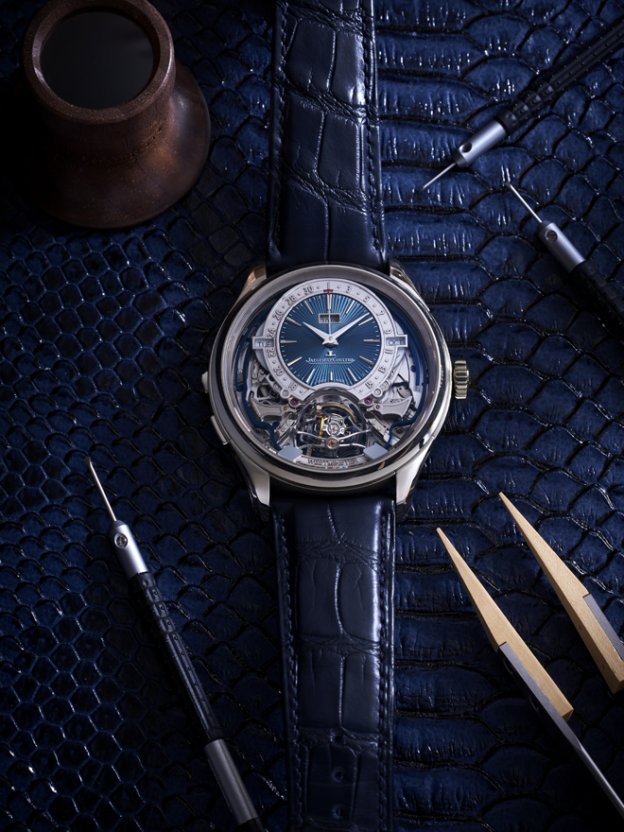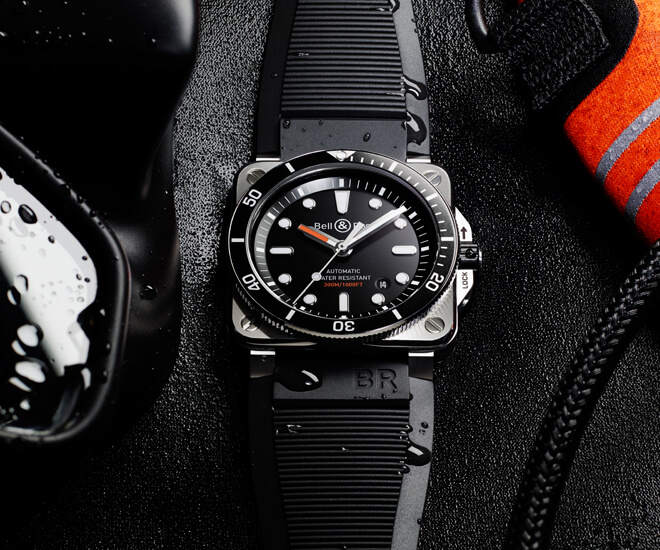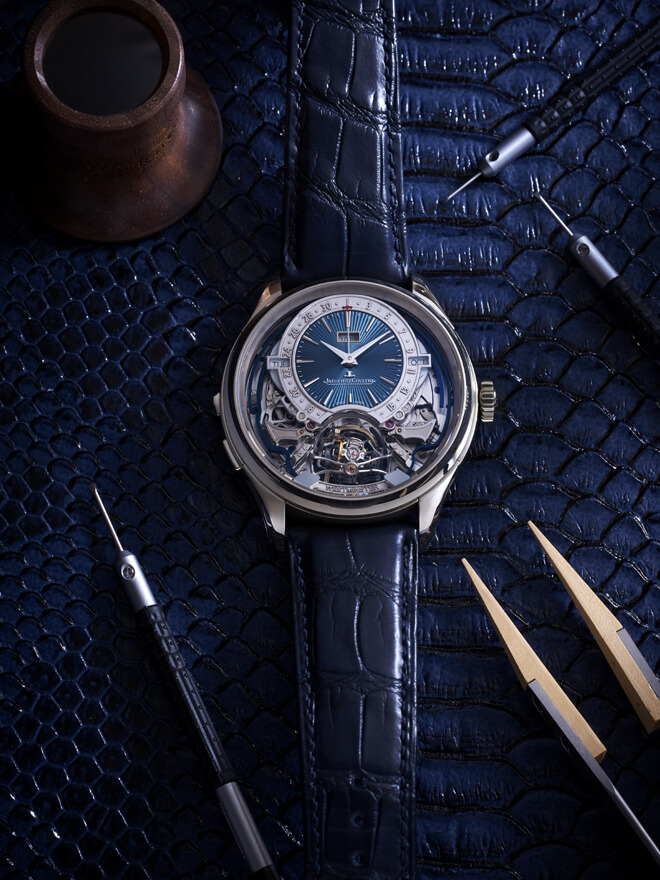
Jaeger-LeCoultre Master Grande Tradition Gyrotourbillon Westminster Perpétuel Image by Ching/GreenPlasticSoldiers
There’s a largely forgotten but relatively recent riddle in fine watchmaking. It made the rounds in 2009, and it goes something like this: how many tourbillons does it take to make the hands of time go round the dial? The answer is anything but straightforward, but it takes the form of a few follow-up questions. If haute horlogerie is your thing then you may find these hilarious.
- Answer number 1: By tourbillons, do you mean to include karusels and carrousels too?
- Answer number 2: Will the tourbillons be single or multi-axis?
- Answer number 3: Are the tourbillons inclined?
- Answer number 4: Wait, do we actually need tourbillons of any kind (or karusels for that matter) to keep good time in a wristwatch?
- Answer number 5: Just kidding, we need as many tourbillons as possible, with as many axes as possible. Obviously, these will all be inclined at every possible angle. In fact, we don’t need hands, dials, or even cases. What we need is lots and lots of tourbillons. Or anything that can pass as a tourbillon. Even a karusel.
That last one is the punchline, although the whole thing works as a bit of a light-hearted jest if one is so inclined. On a serious note, it all makes sense when you think of the tourbillon as a marketing story; a way to tell and sell the story of mechanical watchmaking. Funnily enough, 2009 was also the year that a storied name in Swiss watchmaking decided to make a strong statement about the tourbillon. The manufacture was Jaeger-LeCoultre and the watch was the Reverso Gyrotourbillon 2, which beat out its field of competitors in a proper independent chronometry competition. The Concours International de Chronometrie may be no more, and it certainly had its failings, but this episode did highlight the fact that a tourbillon could play a valuable role in improving the accuracy of a mechanical wristwatch.
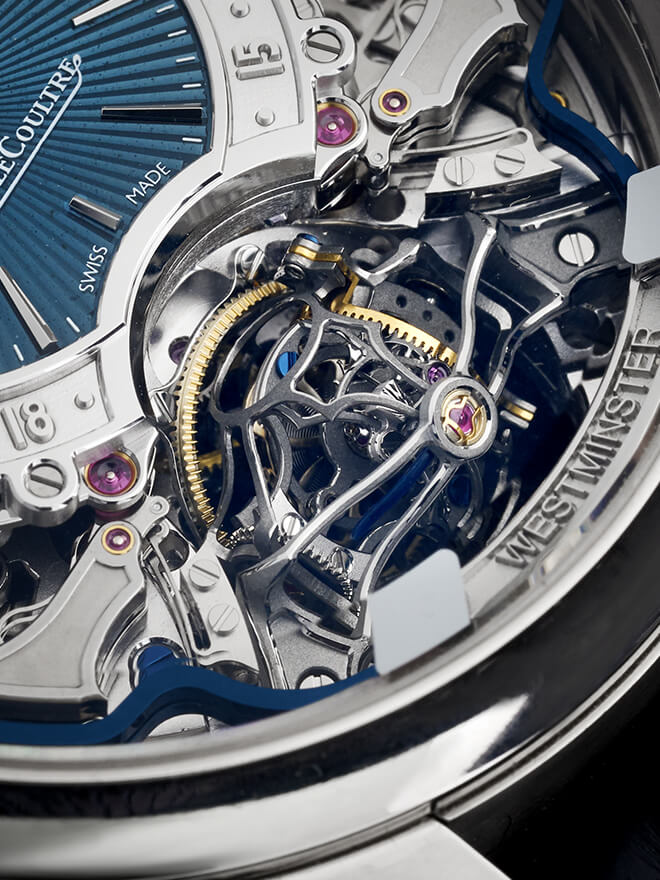
Close up of the gyrotourbillon
Quite obviously then, the aforementioned riddle is a jab at the marketing hype that, more or less, dominated the conversation about fine mechanical watches. Undercutting the hype though are facts such as the triumph of Jaeger-LeCoultre in the chronometry contest. Making the case a little stronger for tourbillons in general, Jaeger-LeCoultre was actually recognised for another tourbillon watch in the 2009 competition: the Master Tourbillon (part of the Master Control collection). Over the years, this particular automatic tourbillon movement has become something of an industry standard for reliability and precision. It is also a standard for Jaeger-LeCoultre, and is part of the collection this year, as you will see.
The key point here is that the tourbillon is only as good as the watchmakers behind it, and the brand philosophy behind them. This point defines what the manufacture Jaeger-LeCoultre brings to the table in terms of its complicated wristwatches, at every level.
The Vallee Beyond
A watch such as the one on our cover this issue, which is covered in more detail elsewhere this issue, tells you everything you need to know about the Le Sentier manufacture’s technical and artisanal competencies just at face value. We were lucky enough to shoot the watch at the SIHH this year, and our friends at WOW Thailand actually featured it on the cover of their Pioneer issue (the equivalent of our Summer issue). Here’s how that story, by editor Ruckdee Chotjinda, tells it: “With over 400 patents across nearly 1,250 calibres, Jaeger-LeCoultre is undoubtedly a true manufacture from the Vallee de Joux – one that strikes the perfect balance between technical prowess and aesthetics.”

Gyrotourbillon cage
The aesthetic qualities the story refers to can be seen most clearly in the solidly classical dial, which features both guillochage and enamel work. The guilloche decoration is done by hand, and when completed the grand feu enamelling follows. The result is a bewitching dial that does not reveal the trade secrets behind its magical appeal. This subtle approach contrasts starkly with the gyrotourbillon and the chiming mechanism, which are both crafted to hold the eye, and to invite speculation on how they work.
Happily, one need not engage in much speculation about the watch and the distinguished calibre 184 that powers it. This manual winding movement is extraordinarily precise, gaining or losing just one second per day. To put that into perspective, to qualify for the industry-leading COSC standard, a mechanical movement need only stay within the -4/+6 seconds per day range. Jaeger-LeCoultre has guaranteed this precision right from the start of the gyrotourbillon story so this is not a surprise. This means that every gyrotourbillon watch from the Master Gyrotourbillon in 2004 onwards boasts this precision. It is this commitment to an excellent timekeeping rate that won Jaeger-LeCoultre the top plaudits at the 2009 chronometry prize.
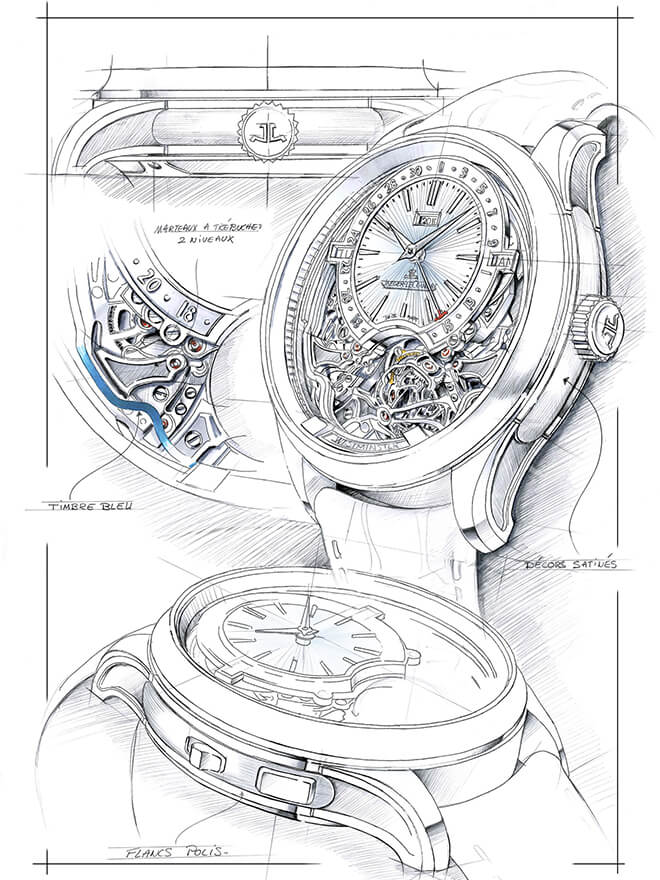
Design sketch of the Master Grande Tradition Gyrotourbillon Westminster Perpétuel
Precision is a big part of the Jaeger-LeCoultre story, as CEO Catherine Rénier reminded us at the SIHH this year. “Precision is at the core of the history…and the business of Jaeger-LeCoultre. It has always been a balance between innovation and the search for precision. Our entry into the world of watchmaking began at simply trying to improve the components of the watch and each calibre beginning with the pinions.” Renier was referencing the manufacture’s invention of the millionometre in 1844 (see the timeline infographic), an achievement it made long before any watches would bear the name LeCoultre.
Chimes at Midnight
Precision even marks that most soulful of complications, the musical rendering of current time. In the Gyrotourbillon 5, an unlikely mechanism has been given a part in the orchestra: the remontoir d’egalite. As covered more fully in our story about constant force mechanisms this issue, the remontoir keeps the energy-hungry gyrotourbillon fed with a steady supply of power (calibre 184 has a power reserve of 52 hours, which given its energy consumption implies a rather large barrel). A powerful mainspring also explains the use of the remontoir as this device can protect the sensitive escapement from the full force of the power supply.
It just so happens that the remontoir is ‘recharged’ by the aforementioned mainspring every minute, and – because it controls the second wheel – this means the minute hand moves in discrete steps, rather than creeping forward. This arrangement explains how the chiming mechanism is more precise in sounding out the minutes; even when the repeater is activated between two minutes, it will still sound out the time down to the correct minute.
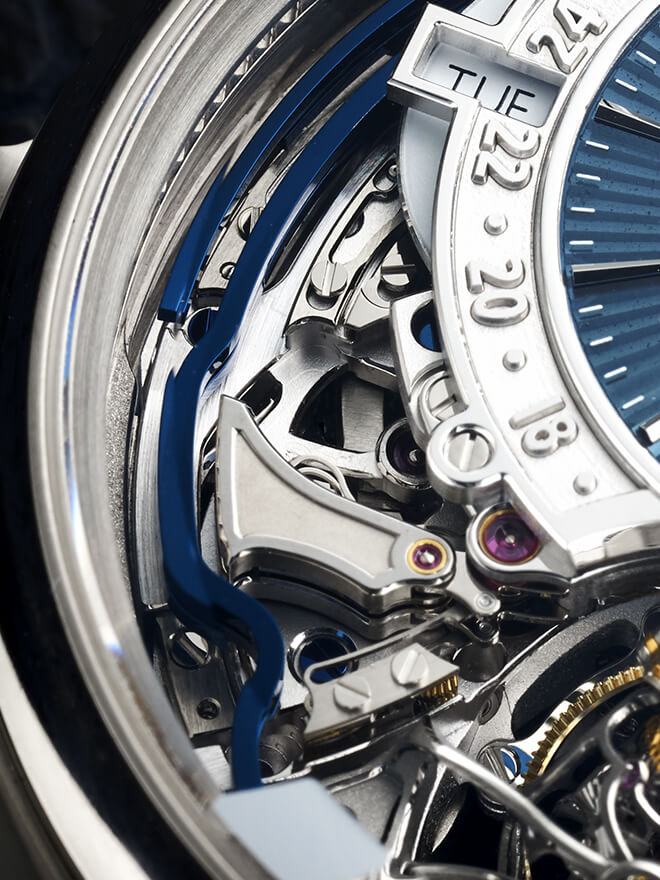
Close up of the minute repeater hammer and patented crystal gong
This brings us to the Westminster chimes, which basically means this is a Big Ben clock on the wrist. Normally, minute repeaters sound out the time with tones denoting the hours, quarters and minutes in a one tone, two-tone and one tone pattern respectively. While beautiful in this simple ding, ding-dong, ding style, Westminster chimes are infinitely richer. What one hears when activating the minute repeater here is a complex four-phrase melody consisting of four notes. See the cover watch story for more details on this. We also recommend Googling Westminster chimes for a recording of what it sounds like.
On that note, the Master Grande Tradition Gyrotourbillon Westminster Perpétuel is about much more than accuracy, as its name clearly states! There’s a reason the watch’s complications are laid out so compellingly, and that there isn’t a seconds hand or counter. There are no less than 12 patents at work here, two of which are new – for the perpetual calendar and for the minute repeater. There is a story to this watch – an emotional narrative about timekeeping that has as much drama as Orson Welles’ The Chimes at Midnight. Indeed, in 2009, when the news was all about technical competency of the manufacture that had so recently produced so many wonders, then-CEO Jerome Lambert (now Richemont CEO) surprisingly turned the conversation to the personality of the Reverso Gyrotourbillon.
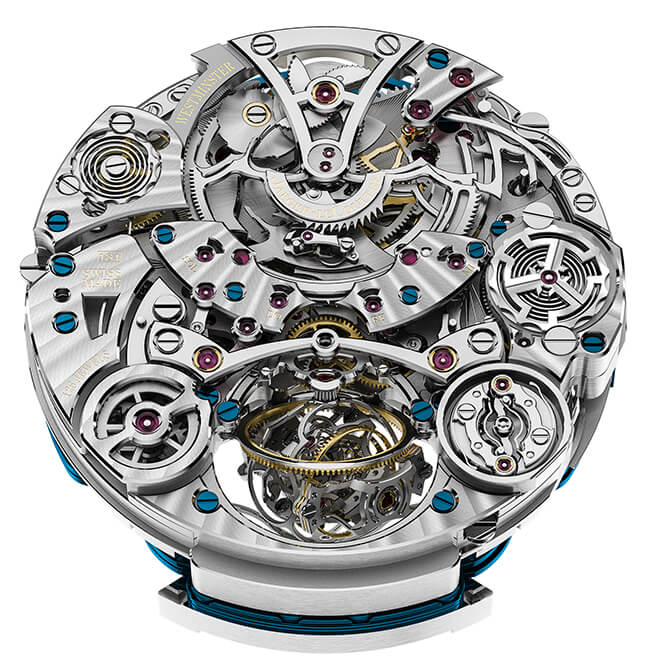
Jaeger-LeCoultre calibre 184
Jaeger-LeCoultre CEOs waste no opportunity to remind journalists that the Grande Maison has mastered every complication and every trick in the watchmaking book, and that its 1,000-plus employees can deploy any horological skill at will. When Lambert was talking about the emotional power of the gyrotourbillon, he might as well have been referring to the fact that the watch was the physical embodiment of the manufacture’s history, traditions and creativity. This is true of every Jaeger-LeCoultre watch but a grand complication, or a bona fide superwatch like the Gyrotourbillon Westminster Perpétuel, puts all the virtues of the manufacture on show. It certainly feels like the gyrotourbillon series of watches, and the Hybris Mechanica for that matter, are all principal players in a grand play about space-time, written and directed by the manufacture Jaeger-LeCoultre.
Insofar as the looks of the watch paint a picture of complexity and subtlety, Jaeger-LeCoultre continues its tradition of using the gyrotourbillon as the pinnacle of its capabilities. “The Gyrotourbillon is the highest expression currently – the gearwork is visible, as are 90 cuts on the enamel, and several executions of each line to create the guilloche. I don’t know what’s the most challenging when this timepiece exists,” said Renier.
All the Bells and Whistles
It is indeed difficult to imagine making a more challenging and technically competent watch, especially in such a compact form; when we saw the Gyro 1 and the Gyro 2 in the metal, as they say, the girth of the watches was not trivial. In the latest gyrotourbillon watch, the fifth such creation, no effort was spared to reduce the size of the gyroscopic tourbillon that gives the Gyrotourbillon series its name. Indeed, the Gyrotourbillon 4, the Reverso Tribute Gyrotourbillon already displayed the manufacture’s commitment to making watches with this complication more wearable.
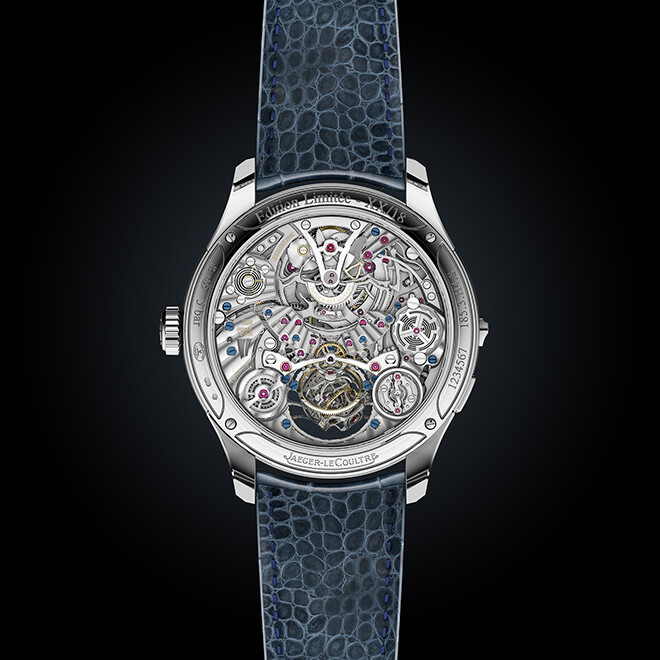
Caseback of the Jaeger-LeCoultre Master Grande Tradition Gyrotourbillon Westminster Perpétuel
The new watch is a not inconsiderable 43mm across but just 14mm thick. That’s just about 4mm thicker than the Master Ultra Thin Moon Enamel, also featured in this story, and 2mm thinner than the Gyrotourbillon 1. The watchmakers played their part in making this new compact aesthetic possible in the Gyrotourbillon 5 by reducing the size of the gyroscopic tourbillon by almost 15%, by means that include the manufacture’s famous Duoplan escapement. Making the tourbillon smaller also means that it has a lower tolerance for errors, thus providing yet another reason the manufacture decided on a remontoir here.
Precision is at the core of the history…and the business of Jaeger-LeCoultre. It has always been a balance between innovation and the search for precision
– Catherine Rénier, CEO Jaeger-LeCoultre
After the era of the grand superwatches such as the Gyrotourbillon 2, the Master Grande Tradition Gyrotourbillon Westminster Perpétuel represents the new frontier in haute horlogerie. For example, it is the first watch in the world with a multi-axis tourbillon, constant force mechanism, Westminster chimes and perpetual calendar. In fact, this is the first time Jaeger-LeCoultre has deployed a remontoir d’égalite.
Precision is an Art
It goes without saying that there are other important watches from the manufacture this year, where the observant can also find the tell-tale signatures of the manufacture. Some of these require a closer look in future issues, or have been singled-out already, such as the Master Grande Tradition Répétition Minutes Perpétuelle (issue #53). A particular favourite of more poetic souls would be the automatic Master Ultra Thin Moon Enamel, which gives pride of place to the one calendar indication that the Gyrotourbillon 5 could not make space for: the moon phase. Connoisseurs will recall that this is not a new watch, with calibre 925 powering several models, including women’s versions. What’s new here is something the watch has in common with the Gyrotourbillon, and the other mainstays of 2019. We are referring of course to the enamel dial.
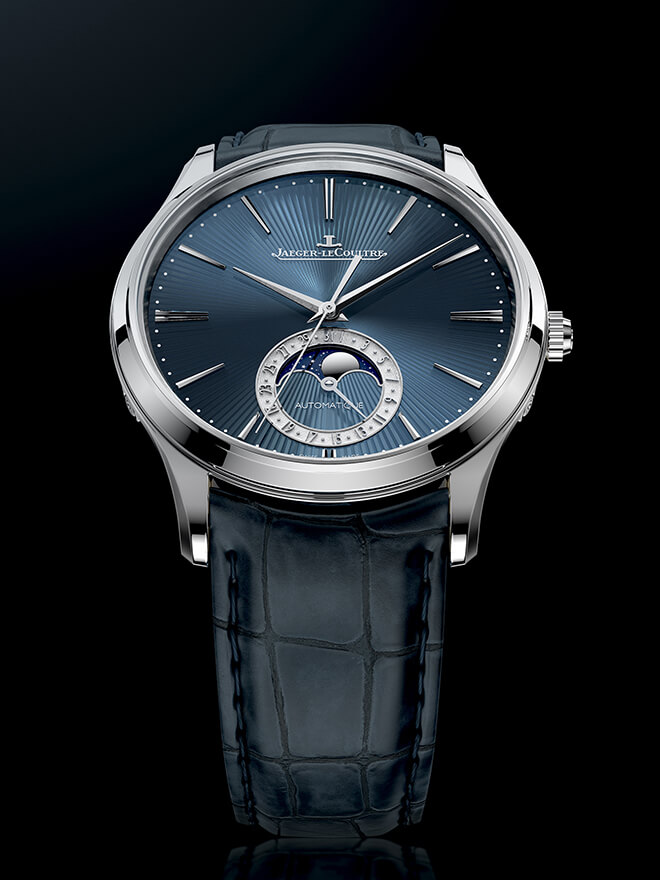
Jaeger-LeCoultre Master Ultra Thin Moon Enamel
Indeed, the enamel dials also remind us that this particular artisanal touch – so easily overlooked by the impatient – has been making waves at the manufacture all along. As noted elsewhere, and reiterated by Rénier, this thoroughly amazing dial could only have been produced in such uniformity and variety by a manufacture with enough depth and strength to have mastered more than 180 skills in-house. Yes, dials can exhibit both uniformity and variety, especially the dials of these new timepieces from Jaeger-LeCoultre.
One 2019 watch in particular that makes a good fit alongside the Gyrotourbillon 5 is the Master Ultra Thin Tourbillon Enamel. Yes the dial is yet another example of Jaeger-LeCoultre’s superlative dials. For a moment though, we find ourselves needing to state that this watch is essentially identical to the 4Hz Master Tourbillon that also triumphed in 2009 chronometry prize. The new watch is powered by the same calibre 978 that brought home the bacon in 2009 for Jaeger-LeCoultre. In 2019, the movement has been tweaked to include a date indicator at 12 o’clock that acts as a nice counterweight to the tourbillon at 6 o’clock. We shall definitely be making space for this watch in Highlights soon.
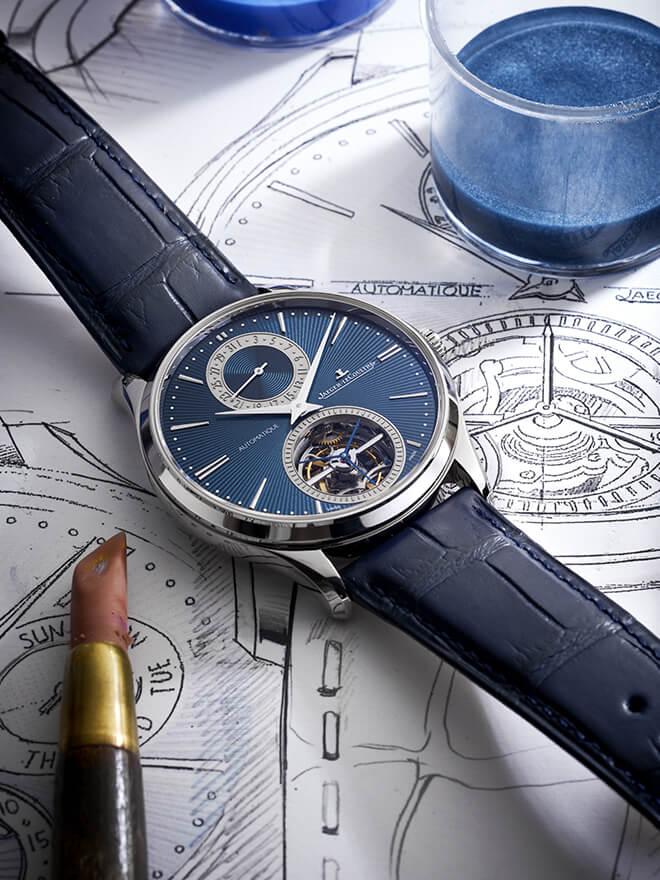
Jaeger-LeCoultre Master Ultra Thin Tourbillon Enamel
Closing things out for 2019 novelties is the Master Ultra Thin Perpétual Enamel, which allows us to note that there are three different perpétual calendars in the Jaeger-LeCoultre assortment this year. Intriguingly, each one has its own particularities and perhaps that is why they each spell the word “perpetual” differently.
